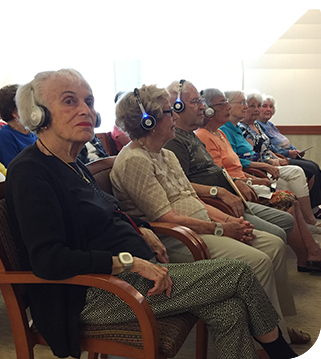Emerging hearing devices help re-discover sound.
How much does hearing loss impact our health as we age? A lot: the condition’s link to physical, social, and emotional complications include, exhaustion, headaches, stress, eating and sleeping problems, and depression. According to the NIH, one third of people between 65 and 74 experience hearing loss, with half of those older than 75 facing hearing difficulties. Auditory health is well known to be closely associated with physical and mental health. Health and wellbeing challenges attributed to hearing impairments include cognitive decline, social isolation, an increase in risk of falls, and a withdrawal from social activities across all levels of care.
“The health and wellness impact of hearing loss can’t be overstated,” says Kari Olson, President of FPCIW. “As we age, the inability to hear conversations and participate in discussions progressively takes us down a path self-isolation, and the mounting evidence of deteriorating health conditions due to social disengagement is impossible to ignore.”
Despite the availability of hearing aids, only 30 percent of adults 70 and older who would benefit from a hearing aid wear them. The reasons are many, but they include accessibility, affordability, and stigma.
An exciting class of accessible, consumer-oriented, and innovative listening devices is emerging in the hearing loss space, and the Front Porch Center for Innovation and Wellbeing (FPCIW) has been exploring these hearing-aid alternatives to address this prevalent issue. With a grant award from the Consumer Technology Association Foundation (CTA), FPCIW has introduced group listening devices and personal sound amplification products (PSAP).
“We’re in the midst of an exciting explosion of hearing solutions that is already disrupting the traditional hearing device market, and the impact potential of these new solutions will be enormous to the wellness, independence, and engagement of older adults,” says FPCIW director Davis Park. “This generous grant from the CTA Foundation enables us to test these consumer solutions and accelerate their adoption.”
In July 2017, FPCIW launched the Hearables for All (HFA) project to address mild to moderate hearing loss among Front Porch residents through a group listening system and personal sound amplification products (PSAPs). FPCIW partnered with Eversound to explore social engagement for group activities, and worked closely with Bose’s Hearphones and Nuheara’s IQBuds. The Hearables for All project spanned 12 senior living and affordable housing communities at Front Porch and CARING Housing communities, and in partnership with several senior serving organizations. The main objective of the project was not to determine whether these products outperformed one another, but rather, to assess the impact of these innovations on social engagement, quality of life, and increased hearing abilities.
Over the course of the study, FPCIW found high engagement and satisfaction among over 730 users of the Eversound system:
- 74.9% reported that they would wear their Eversound headsets to future events.
- 77.4% felt that their Eversound device increased their understanding of the event.
- Care staff reported a 47.8% increase in observed mood and behavior in care centers (skilled nursing), and a 63.8% mood/behavior improvement in memory care.
The opportunity to leverage group listening systems such as Eversound was clear from our test: technologies that address hearing loss in social and community settings, with appropriate training and use, promote engagement and participation.
FPCIW’s evaluation of Personal Sound Amplification Products with 120 older adult users were overall mixed, but some of the key results were encouraging:
- 57.3% of users agreed that their PSAP devices increased their ability to hear
- 39.3% agreed that they were more likely to partake in community events
- 29.1% felt that their PSAP hearable device charged their enjoyment of life for the better
While some of the user concerns over PSAPs focused primarily on design, a more important barrier we identified was the powerful cultural perception and social acceptance of devices that brought attention to hearing impairments. But the rapid developments in PSAPs since our Hearables for All pilot and increased acceptance and prevalence of wireless earbuds offer important opportunities for the further adoption hearable devices for older adults.
The challenges to hearing loss and their negative correlations to a host of health and social outcomes are too difficult to ignore. But as emerging hearable devices and their increased ubiquity only expand to introduce new auditory, voice first, and biometric features, FPCIW will continue to play a role in encouraging older adult adoption of hearable technologies.
Read the CIW’s Final Report about the Hearables for All pilot.
Browse our Hearables for All photo gallery.


